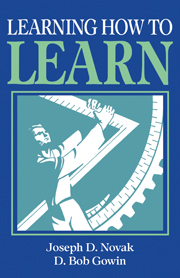Book contents
- Frontmatter
- Contents
- Foreword
- Preface
- Acknowledgments
- 1 Learning about learning
- 2 Concept mapping for meaningful learning
- 3 The Vee heuristic for understanding knowledge and knowledge production
- 4 New strategies for instructional planning
- 5 New strategies for evaluation: concept mapping
- 6 The use of the Vee for evaluation
- 7 The interview as an evaluation tool
- 8 Improving educational research
- Appendixes
- References
- Index
3 - The Vee heuristic for understanding knowledge and knowledge production
Published online by Cambridge University Press: 05 June 2012
- Frontmatter
- Contents
- Foreword
- Preface
- Acknowledgments
- 1 Learning about learning
- 2 Concept mapping for meaningful learning
- 3 The Vee heuristic for understanding knowledge and knowledge production
- 4 New strategies for instructional planning
- 5 New strategies for evaluation: concept mapping
- 6 The use of the Vee for evaluation
- 7 The interview as an evaluation tool
- 8 Improving educational research
- Appendixes
- References
- Index
Summary
WHY USE A HEURISTIC?
Aheuristic is something employed as an aid to solving a problem or understanding a procedure. The Vee heuristic was first developed to help students and instructors clarify the nature and purpose of laboratory work in science. It grew out of a twenty-year search by Gowin for a method to help students understand the structure of knowledge and the ways in which humans produce knowledge, and evolved from his “five questions” procedure, a scheme for “unpacking” the knowledge in any particular field. Since 1977, when the Vee was first introduced to college students and teachers, it has been well received, and we have found it relevant in virtually every discipline represented at a university. In 1978 the heuristic was first introduced to junior high school students to help them “learn how to learn” science, and since then it has been applied as an aid to learning in many fields of study at both the secondary and college levels. One of the objectives of this book is to encourage expanded use and evaluation of the potential of the Vee heuristic.
In Chapter 1 (Figure 1.2) we presented a simple version of the Vee containing the key elements necessary to understand the nature of knowledge and knowledge production. Figure 3.1 shows a more complete Vee containing descriptions and other elements that can be considered. The heavy lines at the base of the Vee serve to emphasize that these are key elements that must be considered carefully in any inquiry.
- Type
- Chapter
- Information
- Learning How to Learn , pp. 55 - 76Publisher: Cambridge University PressPrint publication year: 1984



